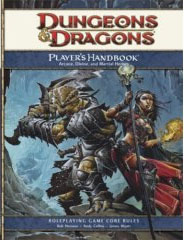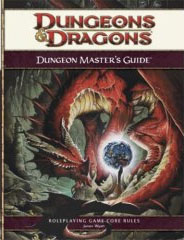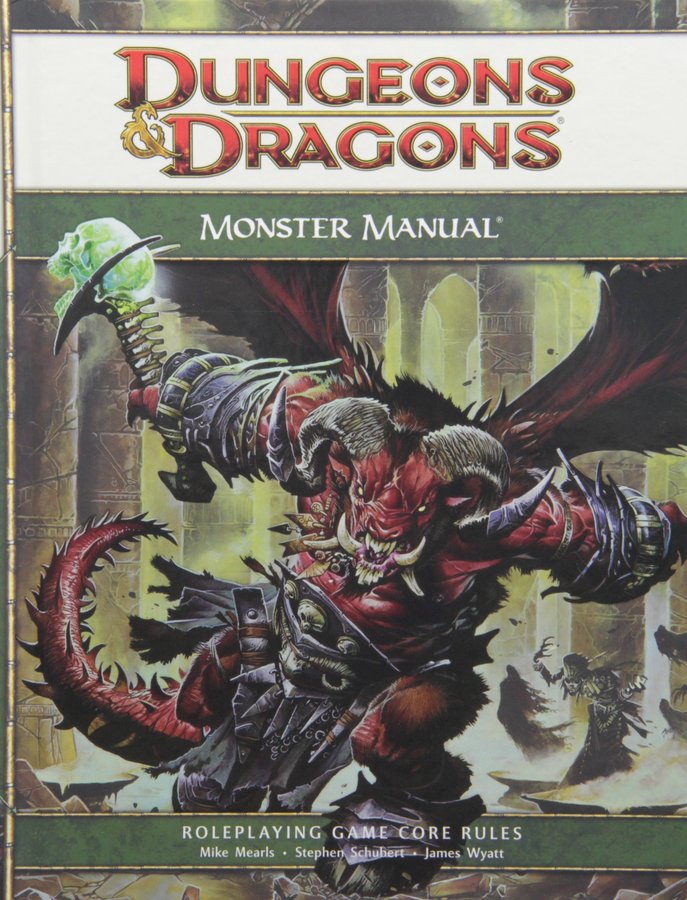 4th Edition has gutted the non-combat portions of the game. It took me awhile to really come to grips with this because there is a large degree to which familiarity with previous editions causes you to simply glaze over what’s missing from the new edition. But once I realized what I was seeing, and really focused on the problem, it quickly became clear that the designers had decided that D&D was a game about combat, combat, and more combat.
4th Edition has gutted the non-combat portions of the game. It took me awhile to really come to grips with this because there is a large degree to which familiarity with previous editions causes you to simply glaze over what’s missing from the new edition. But once I realized what I was seeing, and really focused on the problem, it quickly became clear that the designers had decided that D&D was a game about combat, combat, and more combat.
NON-COMBAT SKILLS: The skill system in 4th Edition has been “simplified”. Part of this means reducing the flexibility and freedom of choice to be found in 3rd Edition (while gaining no appreciable benefit from the loss), but the other part of it is the systematic removal of non-combat skills and non-combat skill uses.
When I have brought this up in discussion with diehard supporters of 4th Edition, I have often been told that I’m wrong: There are still some non-combat skills and skill uses left in the game.
This is true. But if you cut off both my legs and one of my arms, the fact that you left me with one working hand doesn’t mean that you haven’t mutilated me.
Appraise, Craft, Decipher Script, Handle Animal, several Knowledge skills, Perform, Profession, Ride, and Use Rope are all completely gone. Disguise and Forgery have been dumped into the Bluff skill, but have no associated skill uses. (This is the entirety of their description in 4th Edition: “You make a Bluff check to […] pass off a disguise or fake documentation…”)
And when you look at the skills which do remain, non-combat uses for those skills have also been widely removed from the game. (On the other hand, several new combat uses for skills have been added — so it’s not that they were just paring the whole list down.)
In play, this wasn’t just hypothetically problematical. Twice in our very first session of 4th Edition the players ran straight into the wall of missing non-combat skills. And, of course, I was left improvising house rules on the fly to cover over the gaping holes left in the rules.
I don’t expect any rule system to be encyclopedic, but the advantage 3rd Edition had was a comprehensive structure of skills that made improvising non-detailed tasks really simple. In years of playing 3rd Edition, I can’t remember a single time I ran into a situation where I could say, “There’s no skill for that.” Which meant that my task in 3rd Edition was simply figuring out the appropriate DC to use. In mere hours of playing 4th Edition we ran into “there’s no skill for that” multiple times, necessitating the creation of entire mechanics. (The sheer number of mandatory minor house rules you have to track in order to run 4th Edition in a consistent fashion is truly mind-boggling to me.)
What leaves me scratching my head over this design decision is that, with the new method of handling skills at character creation, it was so totally unnecessary. The only legitimate complaint against having lots of skills in 3rd Edition is that some PC classes arguably don’t have enough skill points to take a significant selection of those skills. However, in 4th Edition that concern has been completely negated. So why not invest the 2 or 3 pages of text it would have taken to provide the same level of comprehensive support for non-combat skill use in 4th Edition that you had in 3rd Edition?
NON-COMBAT EQUIPMENT: I’ve talked about this before, but all non-adventuring equipment and most of the non-combat adventuring equipment has gone M.I.A. in 4th Edition. This includes staples of the dungeon crawling genre like 10-foot poles, chalk dust, and the like.
NON-COMBAT POWERS: Finally, when you compare the spells and class abilities in 3rd Edition to the powers and rituals available in 4th Edition the new game’s wholesale embrace of combat and systematic rejection of non-combat play becomes pretty obvious. And this, naturally, spills over into the magic items available in the game, as well.
As with skills, it’s not as if there aren’t any non-combat powers in 4th Edition. It’s just that the number of non-combat options have been drastically reduced, while the number of combat options has been increased.
COMBAT, COMBAT, COMBAT: Of course, it’s not as if D&D has ever been a combat-lite game. But 4th Edition puts its hand firmly on the combat side of the scale and pushes down hard. Frankly, the game hasn’t been this myopic in its combat-focus since the original 1974 boxed set… and that was when the game was little more than an expansion pack for the Chainmail tactical miniatures game.
The simple reality here is that D&D miniatures are, by all accounts, more profitable for WotC than D&D books are. It’s little wonder, I suppose, that we have been given rules that look like a tactical miniatures game and adventures which are explicitly designed as a series of tactical combat encounters complete with set-up instructions for the miniatures.
Personally, I have little interest in the direction this has taken the game. Tactical miniatures combat is not the primary reason I play roleplaying games. And, honestly, I feel that WotC has made a wider strategic mistake. They have stated that one of their design goals with 4th Edition was to appeal to a new generation of gamers and that, to win the attention of that generation, they would need to compete against video games like World of Warcraft and Diablo.
But the people who play D&D for the excitement of hack ‘n slash combat are the players you are least likely to retain in a head-to-head matchup with computer and video games. You can get the same basic style of combat in Diablo, after all. But you get it faster, with prettier graphics, and without having to do the math. Plus, you can play any time you want to. You can even play with your friends (whether they live near you or not), and with a minimal effort (no larger than hauling a sizable miniature collection around) you can set up a LAN party and play with them in person.
Don’t get me wrong: I like having a robust and tactically interesting combat system in D&D. But I believe that, if you want your pen ‘n paper roleplaying games to compete with the video variety, then you shouldn’t be trying to compete with the greatest strengths of video games. D&D will never beat the Diablos of the world when it comes to combat simulation, graphics, or ease of play.
Where pen ‘n paper roleplaying games can separate themselves from the video variety is outside of combat. It is the truly open-ended nature of the game — the GM’s ability to respond to any scenario or action the players might propose — that video games are still decades away from emulating.
I was hoping that D&D would move towards those strengths, while still retaining all the benefits of its dungeon crawling roots (this really is a situation where you can have your cake and eat it, too). Instead, with 4th Edition, the game embraced its weaknesses.













